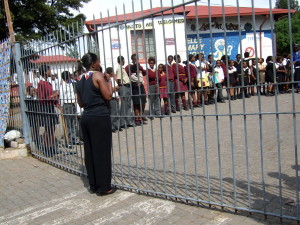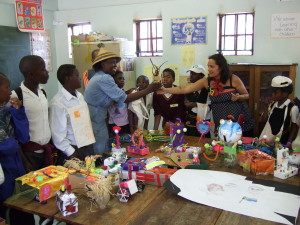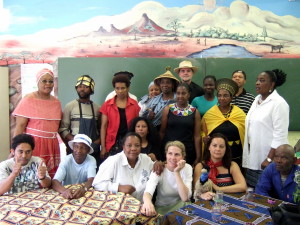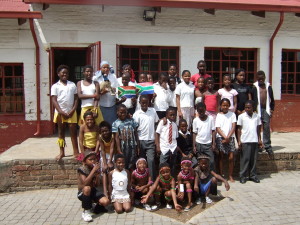A paper presented to the Craft in the 21st Century conference in Edinburgh (2002)

km1a
It seems these days we are blessed, or cursed, by long-term incumbent governments. Yet despite their seeming inexorable hold on power, we know that eventually, as night follows day, the UK will eventually be Tory and Australia will be Labor.
For Hegel, the popular understanding of the dialectic is expressed in the phrase, ‘Live and let live… each should have its turn…’ While Hegel’s logic is most commonly applied to the relationships of social class, dialectics can be useful in understanding other hierarchies, such as the one we all live in-the world. History has conspired to divide the world up into quarters-north and south, east and west. The uneasy relationship between these parts has provided the engine of much that we know of as world history. Today, the process of globalisation is seen to realise the dominance of one quarter over another-the west over the east, and the north over the south.
The role of craft in this world dialectic is particularly interesting. The crafts movement has defined itself by reference to the creative energies of the northern peoples. We can see today, though, a new destiny for craft in the post-colonial predicament of the south. The purpose of this paper is to outline what this destiny might entail.
To find our way south, in the space of a few minutes, we need to begin at the start of our journey—the west.
Orientalism
The Greek world view was defined by contrast with the barbarians beyond its borders. The Persians by Aeschylus is the earliest known Greek play, taking as its theme the invasion from the east. After the defeat of Xerxes’ Persian armies in 490 BC, the chorus laments:
Now All Asia’s lands
Moan in emptiness
For post-colonialist Edward Said, this play sets the stage for the dialectic of orientalism that dominates the West’s imagining of the east in centuries to follow: to Asia is a lost glorious past that only the West can recover. I’m sure that we are all familiar with this position and it doesn’t bear rehearsing here.
Orientalism was clearly important in the development of Western decorative arts. Styles such as Chinoiserie helped the rigid Europeans break out of their rigid conventions and embrace the arabesque.
North-ism
But such exoticism is vulnerable to the inevitable criticism of decadence. In the late nineteenth century, the Arts & Craft movement proposed an alternative polarity that replaced the lost civilisation of the East with one more directly related to Europeans—the noble world of the north. The spiritual centre of William Morris’s craft revolution was Iceland, which he described a ‘holy land’, evoking the romance of the Norse sagas. On a parallel path, John Ruskin praised the ‘magnificent enthusiasm’ of the Gothic.
Along the vertical moral axis of the Arts & Craft movement, the vigorous character of the north is contrasted with stultifying hierarchies of the Latinate south. There were ample precedents for such a hierarchy. Germania, written by Tacitus in the first century, marvelled at the rude energies of the northern races. In the mid-eighteenth century, Montesquieu’s The Spirit of the Laws laid the philosophical foundation of the European state with a climatic analysis of politics, contrasting the sincere north with the passionate south.
This movement certainly had its timeliness.
This North-ism is an occidentalist alternative to the decadent fascination with an exotic orient. It turns the gaze back on the orientalist to question his own lost origins. But the dialectic never rests: North-ism leads to its own alternative (with an interest) in the spontaneous creative energy that lies in the south.
‘Each should have its turn.’
South-ism
In the early twentieth-century, many French artists looked south to refresh their jaded imaginations. In 1930, Henri Matisse travelled to Tahiti ‘to find simpler ways which won’t stifle the spirit’. One of the distinctive crafts in that part of Polynesia is tivaevae, appliqué quilts in bright colours. This flat decorative style re-emerges in Matisse’s later works using the cut-out technique, such as the Jazz series. As far as we know, Matisse established no enduring relationship with Tahitian crafts practitioners. His debt to their tradition is never acknowledged.
Closer to our time, this primitivist idealisation is often directed to the indigenous races of the south. The 1989 exhibition Magicien de la Terre invited third world artisans who had for so long been an inspiration to French artists. They were taken out of their ethnographic cabinet to sit alongside the individual western artists in a contemporary art setting. Magicien de la Terre was widely criticised for its Benetton-like global context. These artisans were the exotic guests in a modernist palace.
At this point, I should acknowledge the hospitality of Edinburgh College of Art in allowing ten Australasian jewellers to present their work in conjunction with this conference. Guild Unlimited works its way into this argument as a neoclassical regeneration from the antipodes: the intensely hierarchical structures of guild from the old north are here opened up to a pluralistic imagination of the new colonies.
Returning to south-ism, there have been attempts in Australian decorative arts by those originally from the north to incorporate indigenous motifs. The Australian printmaker Margaret Preston called for a new school of decorative arts influenced by Aboriginal designs. In 1925, she called for a national theme based on indigenous crafts:
. I have studied the aboriginal’s art and have applied their designs to the simple things in life, hoping that the craftsman will succeed where, until now, the artist has certainly failed.
Though artists like Preston seemed to celebrate indigenous culture, they were largely oblivious to the need for Aboriginal participation in this process.
This brings us to the post-colonial phase of the world dialectic, when the subaltern eventually asks to take the lead. In their recent book Empire, Hardt and Negri draw on Sartre’s concept of the ‘the moment of the boomerang’ to describe this phase. Here the exotic other begins to speak back, and so Aboriginal Australians began to increasingly assert their independence. In Australia, every important occasion is now preceded by an acknowledgment of traditional owners.
Thus we have seen a flowering of Aboriginal crafts in Australia. Just to take one example, Tiwi Island ceramics, originally established by Michael Cardew, was recently revived and exhibited as Yikwani, containing sculptural works of great invention.
Craft has become so associated with Aboriginal culture that in a recent government report (Inquiry into the Contemporary Visual Arts and Crafts by Rupert Myer), the generic term ‘Art and Craft Centres’ was used to describe Aboriginal places for making art. It was assumed that an ‘Art and Craft Centre’ would not be something that non-indigenous Australians would use.
We might feel a sense of completion with such an arrangement, as though we were at the natural end of the dialectic, when the passive object of colonial fascination is finally the active agent in the construction of their own culture. Yet, as Soviet Marxists found to their dismay, the dialectic is never finished. What is the sound of one hand clapping?
The indigenous flowering of craft occurs surrounded by a non-indigenous audience. They are the writers, curators, gallery visitors, administrators, bureaucrats, art advisors and connoisseurs. They are the silent participants, enjoying the other’s enjoyment.
As the identity of place is increasingly deferred to the original people, the moral tenure of northerners gone south becomes problematic. The question is raised: what can they give in exchange for the exotic delights they receive from the southern peoples?
And here we come to the present crisis in south-ism. In recent years, this has become especially evident with the defeat of apartheid in South Africa, and the increasing recognition of first peoples in Australia and New Zealand.
Politically, bi-polar dialogue seems stymied with fears of land claims. Sport is often seen as the level playing field for Western and traditional, but there is little evolution of understanding. However, quietly working away in their studios, craft practitioners are stitching, soldering and dove-tailing together two otherwise incompatible cultures.
I’d like to mention briefly some developments in what used to be called the ‘southern dominions’.
Australia
To begin in Australia, textiles tend to be the preferred medium for craft exchange between indigenous and non-indigenous cultures. In Western Australia, the fibre artist Nalda Searles has developed a strong collaborative method with Aboriginal artists—Noongar in the south and Ngaanyatjarra in the Western desert.
In her art, Nalda Searles has been exploring ways of combining natural and man-made fibres. This includes embroidery of flora on found fabric, such as blankets and clothes. Her work reflects on the tenuous place of white people in this land. Searle’s signature piece is White Boy Blazer, a school uniform on which have been sewn the brachia of Xanthorrhea, known colloquially as Black Boy. Each of these brachia has been painted white, showing the uneasy tension between settlement and the wild bush beyond.
As a result of her long involvement with Ngaanyatjarra people, Nalda Searles is known by the word Kabbarli, which means ‘grandmother’. This term had been applied most famously to another woman living in the Nullarbor Plain a century earlier—Daisy Bates. Searles is currently developing a series of works that explore the confrontation between European dress and the more natural indigenous ornament. Bates’ morning toilet is a fascinating ordeal of Western decorum sustained in dramatic isolation. She writes,
I made my toilet to a chorus of impatient twittering. It was a fastidious toilet, for throughout my life I have adhered to the simple but exact dictates of fashion as I left it, when Victoria was queen—a neat white blouse, stuff collar and ribbon tie, a dark skirt and coast, stout and serviceable, trim shows and neat black stockings, a sailor hat and a fly-veil, and, for my excursions to the camps, always a dust-coat and a sunshade. Not until I was in meticulous order would I emerge from my tent, dressed for the day. My first greeting was for the birds.
This encounter between Western dress and southern wild nature provides the perfect scene for Searles’ craft process. Initi gloves combines the white gloves that Daisy Bates wore all the time during her dealings with the Aborigines and the initi seeds that they wore in their hair.
Searles’ combines both modern and traditional elements in a way that exposes their separation.
New Zealand
The dialogue mellows as we cross the Tasman Sea. There has been a more consistent history of reciprocal dealings between the Maori’s and their British guests. In the spirit of bi-culturalism, those of European descent refer to themselves as Maori term, Pakeha, meaning ‘those who arrive on ships with tall white sails’.
In the twentieth-century, there was much interest by Pakeha in the Maori ornamental traditions. This culminated in the Stone, Bone & Shell exhibition which toured Australia in 1988. It included jewellers and sculptors who drew from the Maori carving traditions, especially using Pounamu, or greenstone.
In 1998, the school was criticised for its appropriation of Maori culture. The jeweller Warwick Freeman was singled out as a ‘plunderer of the Pacific’. At a conference in Hobart in 1998, Freeman defended his practice as a form of dialogue between cultures.
Bi-culturalism calls for active exchange between the cultures—art is a fundamental participant in this engagement—it functions well in the so called ‘negotiated space’ – the space between two cultures
More recently in New Zealand, there have been a number of Polynesian artists, especially from Samoa, who have begun to exploit this irony. Niki Hastings-McFall is of Samoan descent and combines in her work reference to traditional islander forms and modern symbols, such as the conjunction of Solomon Island breastplates and modern symbols such as mag wheels. Her series ‘Flock’ uses the techniques of traditional breastplates but incorporates alternative materials, pearl shell and silver. Included in the radial design are aeroplane symbols which reflect an ironic continuity of traditional and modern.
For all the inevitable conflicts and misunderstandings, New Zealand craft appears to play on a relatively reciprocal exchange between Western and traditional cultures.
South Africa
The parallel path of relations between first and subsequent peoples has taken a dramatic turn in South Africa. Under the Dutch Reform Church, Afrikaners saw themselves as the chosen people and their Great Trek was a journey to the Promised Land. Now, in the Rainbow Nation, they must take their place amongst the heathens not as masters but as equals.
Apartheid had extended to the arts as much as politics. There had been little appropriation of African crafts by settler artists. The curios that could be purchased during holiday treks to the Transvaal were largely imported from countries like Congo and Nigeria.
It’s different now.
New crafts have emerged as hybrids of traditional technique and modern lifestyle. Telephone wire weaving was developed initially by city nightwatchmen, who sought to fill their time by weaving as they would in their village home. Without natural grasses, they were forced to gather whatever was to hand. Odd pieces of telephone wire provided particularly colourful materials for weaving.
Today, telephone wire weaving has become the main source of income for villages like the township of Umlassi in Durban. It has reached the stage now where the main telecommunications company Telkom distribute the wire for free—for the practical reason that otherwise people would steal wires off the poles and so disrupt the telephone system.
While these crafts provide important sources of income, they have not as yet been able to establish themselves as individual artists with reputations in their own right.
Among visual artists gaining reputation in the new South Africa are Zulu men who aspire to the status as healers. These are often charismatic figures whose work is informed by visions.
Lange Magwa looks particularly to objects that are held as sacred to both Western and traditional cultures. ‘Made in China’ is a large gramophone horn woven from cow hide, inside which is a speaker broadcasting in different languages represented in Durban radio. It rests on a springbok hide which is laid over an Indian fabric. For Magwa, his work aims to operate magically to heal the rift between the three main races of Durban. In Zulu ritual, the horn is used as a symbol of magical protection: it can be ground up as healing powder, used as a container of medicine or added to other objects, like a house, to protect it from evil spirit. By finding a link with the European white magic of the gramophone, Magwa is extending the power of the horn into the new South Africa.
So where does this leave white Africans? Many white artists have moved now from their own work to facilitating others. One such artist is Andries Botha. He has established a philanthropic project, Amazini Abisifazane (Voices of Women). This is a cooperative venture presenting embroideries by women about their traumatic experiences. While such projects are important to the economic development of the new South Africa, they do risk entrenching a victimary identity on the previously disadvantaged.
Botha’s own sculptural installations move towards greater self-understanding. In his monumental series What is a Home (1995), a three-metre high steel-plated man with Afrikaner hat is clutching a straw woman in Zulu headdress performing a dance known in Afrikaans as binne boet (‘inside the arse’). In his own work, Andreas is attempting to uncover the folk tradition of Afrikaner culture to find something that is more complementary to the Zulu values.
Contemporary sculptors in the new South Africa are drawing on their own craft traditions to weave together the black and white cultures that have been kept strictly separate during most of their lives. There’s a long way to make up.
Magicians of the south
And here we get to the bottom of things. The bottom of the world is emerging as a forum whereby the European self and its exotic other can finally meet and engage in reciprocal dialogue. This ‘south’ offers a backstage where the exotic actors can exchange masks with their ordinary audience.
In this setting, craft provides an important common language whereby exchange can develop between traditional artisans and Western artists. Old techniques can combine with introduced materials. Alien symbols emerge out of traditional patterns. Using the charismatic authority of magicians, prophets, healers and artists, these individuals can realise new similarities and differences between the two worlds that find each other in the south.
The wrongs of the past certainly demand reparation. Someone needs to say sorry. But the process of empowerment still bears the legacy of colonial paternalism. ‘Live and let live’ carries an onerous responsibility—not only to allow others to fulfil their lives, but live one’s own as well. While global culture offers a nowhere-land of vicarious experience, the local cultures of the south provide a way of re-orienting ourselves where we are, if we can listen.
References
G.W.F. Hegel Logic (trans. W. Wallace) Oxford: Oxford University Press, 1975 (orig. 1830)
Edward Said Orientalism New York: Pantheon, 1978, p. 57
Fiona MacCarthy William Morris: A Life for Our Times London: Faber, 1994, p. 309
John Ruskin Stones of Venice New York: Da Capo Press, 1960 (orig. 1853), p. 176
Thomas McEvilley Art & otherness: crisis in cultural identity Kingston, NY: Documentext/McPherson, 1992, pp. 69-70
Margaret Preston ‘The indigenous art of Australia’ Art in Australia 1925, , pp. 3-11
Michael Hardt & Antonio Negri Empire Cambridge, Mass.: Harvard University Press, 2001, p. 130
Daisy Bates The Passing Of The Aborigines: A Lifetime Spent Among The Natives Of Australia London: Murray, 1938, p. 198







